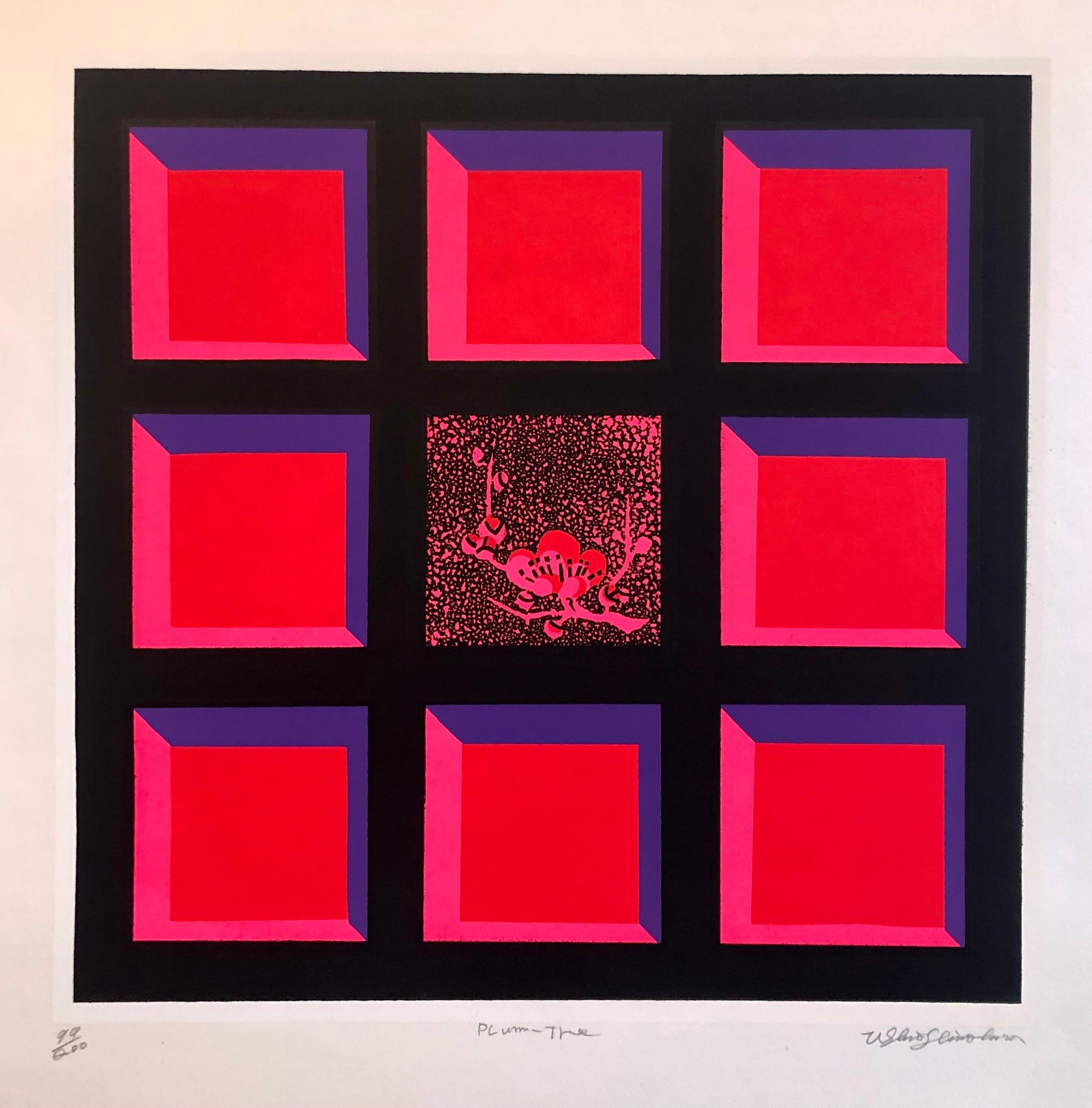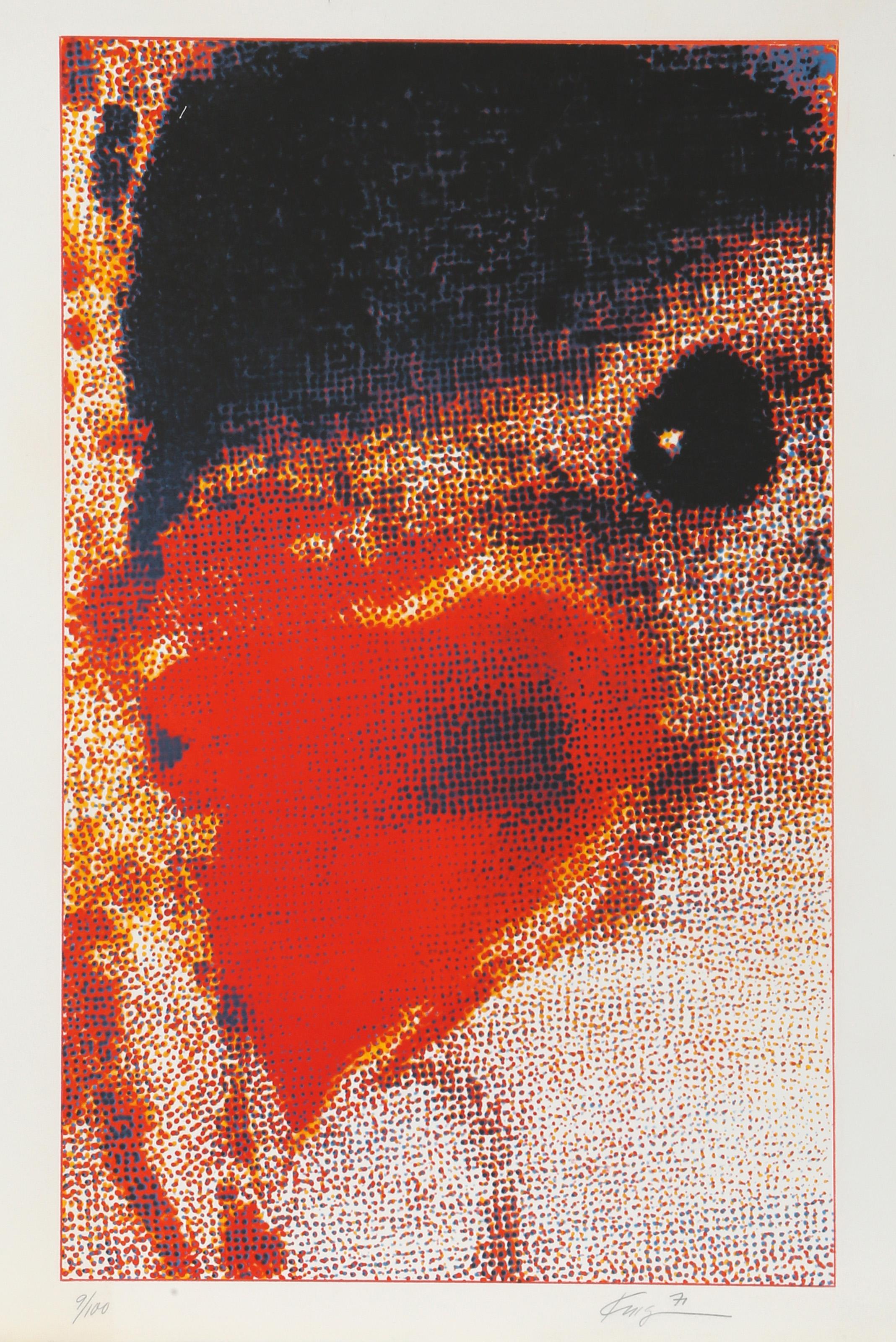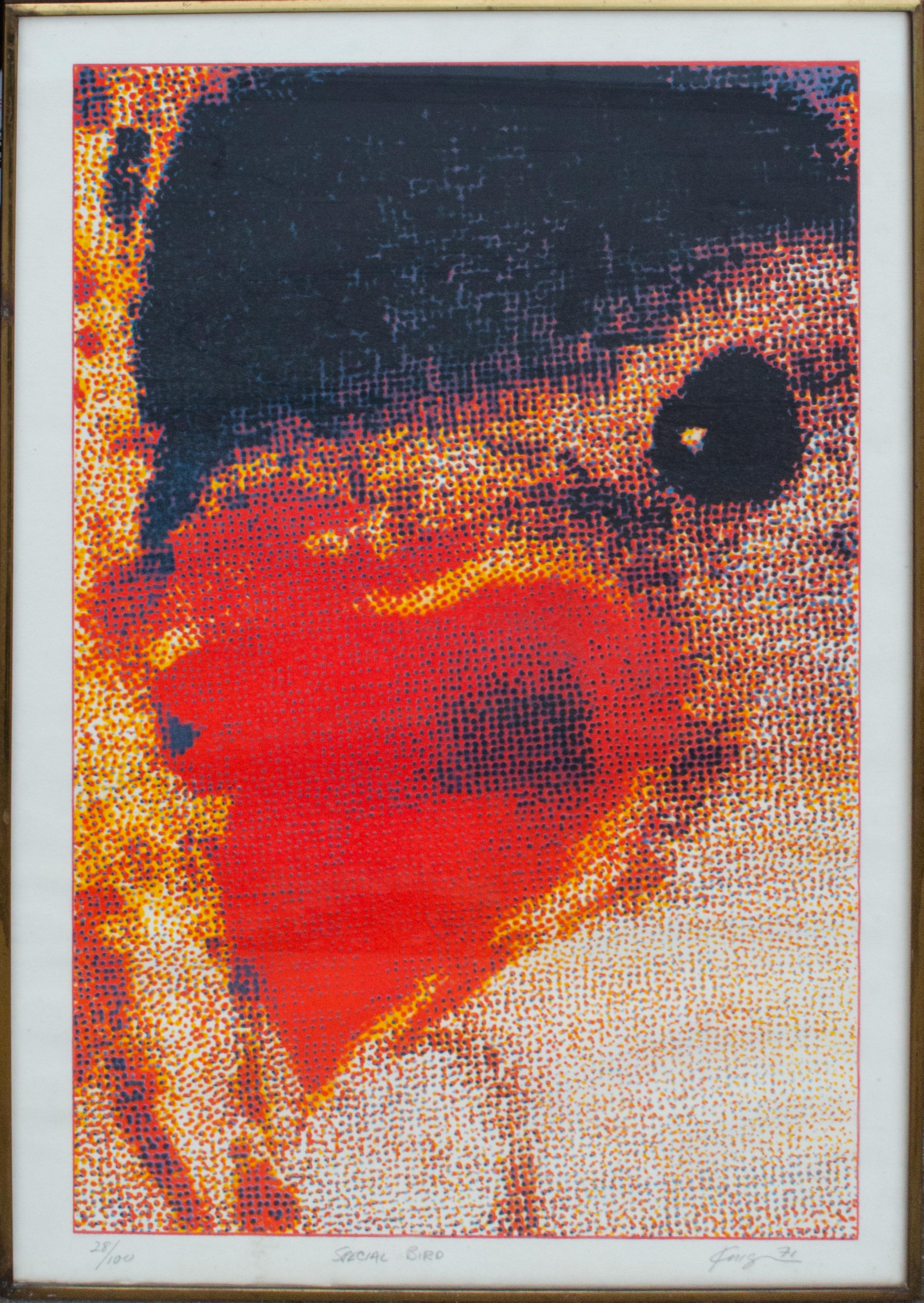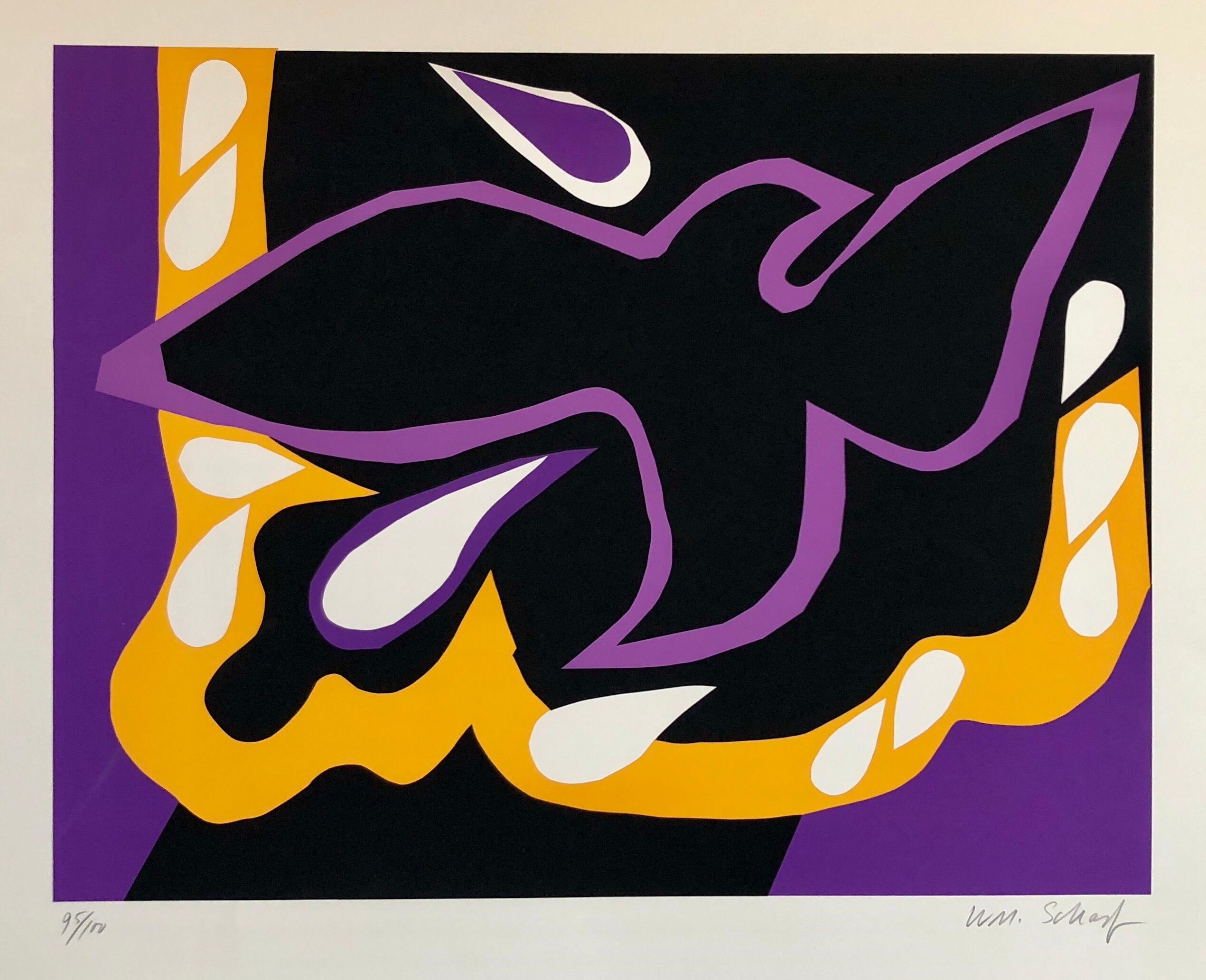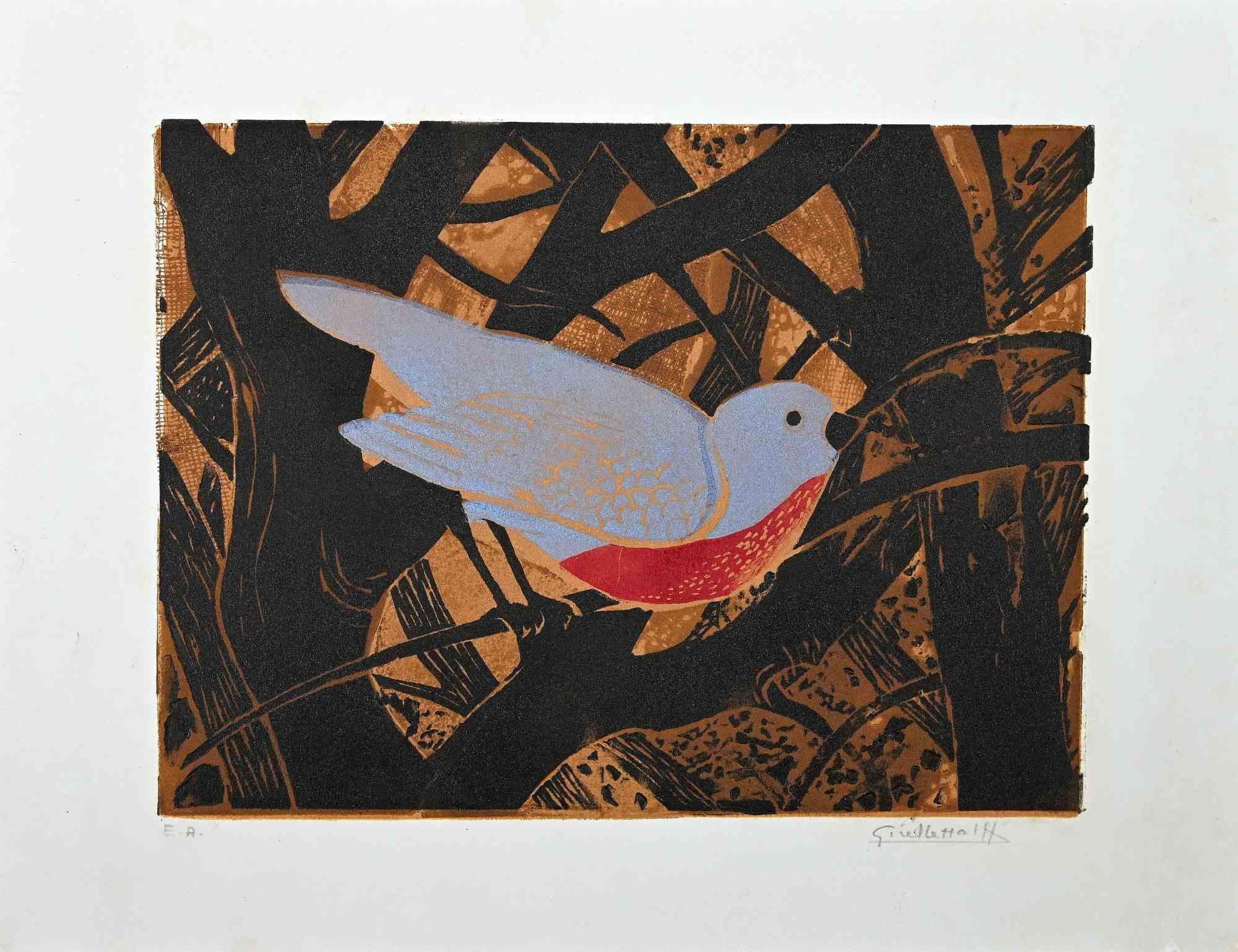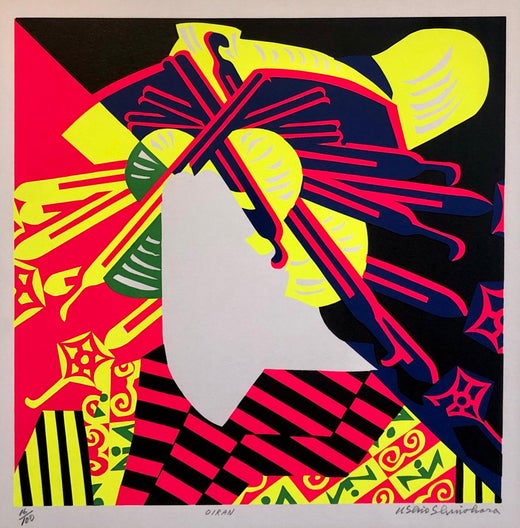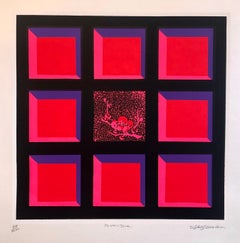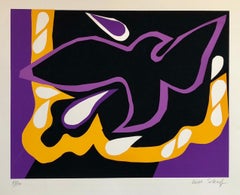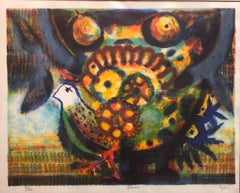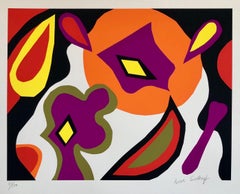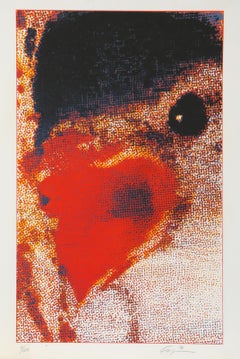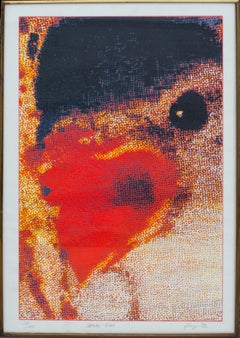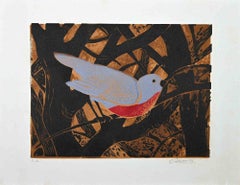Items Similar to Silkscreen Day Glo Fluorescent Japanese Gyu-chan Neo Dada Art Print Birdie Litho
Want more images or videos?
Request additional images or videos from the seller
1 of 13
Ushio ShinoharaSilkscreen Day Glo Fluorescent Japanese Gyu-chan Neo Dada Art Print Birdie Lithoc.1969
c.1969
$1,600
£1,220.84
€1,388.80
CA$2,246.92
A$2,458.98
CHF 1,299.36
MX$29,349.57
NOK 16,581.40
SEK 15,165.04
DKK 10,373.62
About the Item
19 x 15.5 with backing 12 x 12 image
Ushio Shinohara (born 1932, Tokyo), nicknamed “Gyu-chan”, is a Japanese Neo-Dadaist artist. His bright, large work has been exhibited internationally at institutions including the Hara Museum of Contemporary Art, Centre Georges Pompidou, the Guggenheim Museum SoHo, National Museum of Modern Art, Tokyo, Leo Castelli Gallery, New York, Museum of Contemporary Art, Los Angeles and The Metropolitan Museum of Art, Seoul and others. Shinohara and his wife, Noriko, are the subjects of a documentary film by Zachary Heinzerling called Cutie and the Boxer (2013).
Shinohara's parents instilled in him a love for painters such as Paul Cézanne, Vincent Van Gogh and Paul Gauguin. His father was a tanka poet who was taught by Wakayama Bokusui. Shinohara’s mother was a painter who went to the Woman’s Art University (Joshibijutsu Daigaku) in Tokyo.
In 1952 Shinohara entered the Tokyo Art University (later renamed to Tokyo University of the Arts), majoring in oil painting, however he left before graduation in 1957.
In 1960 Shinohara participated in a group called "Neo-Dada Organizers". (Masunobu Yoshimura, Genpei Akasegawa, Shusaku Arakawa, Ushio Shinohara, Sho Kazakura, Tomio Miki, Tetsumi Kudo, Natsuyuki Nakanishi) This group of artists showed their works of art in an exhibition in the 1960s called the Yomiuri Independent Exhibition. This exhibition was sponsored by a newspaper, was open to the public, and was not judged by anyone. This type of exhibition was a form of an anti-salon and was a stepping stone for Shinohara’s sculptures of found objects which acquired the label of “junk art.” Later, while living in New York, to save money on canvases (which were and are expensive) Ushio would wander alleyways collecting scraps of cardboard which he would bring back to his studio, wash, and then use to create his sculptures (so-called "junk art") composed of other found objects including discarded trash, motorcycle parts, and other mass-produced tokens of modern society.
The Neo Dadaism Organizers, including fellow Yomiuri Independent Exhibition participants Akasegawa Genpei, Shusaku Arakawa, and Yoshimura Masanobu, eventually transitioned into the Neo-Dada movement. The Neo-Dada movement can be considered a phase into Pop Art and was influenced by many of the avant-garde artists. The art that was crafted during the Neo-Dada movement was made with everyday items. (An artist who was influenced by Neo-Dadaism was Andy Warhol.)
During this time Shinohara created work called “boxing paintings” in which the artist dipped boxing gloves in sumi ink or paint and punched paper or canvas to splatter it with pigment.
Shinohara, similar to many action-painting oriented artists of the 1950s and 1960s, cared more for the gesture and vitality and less for the beauty of the image. As Julia Cassim observed in her 1993 review of Shinohara's retrospective at Tsukashin Hall in Amagasaki, Japan, “His kaleidoscopic paintings of pneumatic, rubber-nippled nudes, bikers and Coney Island’s garish glories are painted in the acid reds, greens and pinks common to Asian street fairs from Tokyo to Bombay. They burst at the seams with detail. Seemingly slapdash and rapidly painted, they are, in fact, as carefully composed as any more formal work.”
By 1965 the Neo-Dada Organizers group gave way and Shinohara left for New York in 1969 with a grant from the John D. Rockefeller 3rd Fund To visit New York was Shinohara’s dream; he left with the intention of staying in New York for a short period to work and create new ideas because of the different surroundings. He came to love the city's spirit and the mix of ethnicities so much he decided not to return to Japan. In New York he loved being a tourist and getting inspiration from anything and anyone he ran into. He kept with the concept of reinventing American art such as comics and Neo-Dada works. In 1965, before Shinohara left for New York, he started one of his most successful series of works is called "Oiran". An oiran is a title given to a courtesan. Instead of making his work look beautiful to represent what an oiran's personality was like, he made her look ugly and based this work off work in the Edo period (1603–1868). This period can, in a way, be called the beginning of the modern period of Japan. The "Oiran" work was a backlash or rejection of what society believed to be beautiful. He used fluorescent paint and showed the grotesque beauty that was ignored many times in Japanese art. Kimono detail. For the "Oiran Series", Shinohara was awarded a prize by the William and Norma Copley Foundation.His next works of art became motorcycles done around 1970. In his mind, motorcycles represented America. He created these works out of discarded objects — primarily scraps of cardboard he washed and soaked in water to make them pliant, shaping them almost like papier-mâché. They were rough, vigorous sculptures. The motorcycles were reminiscent of what America meant to him, but many times these sculptures had geishas riding on the back seat. The sculptures were painted in shades of green, pink and red which paralleled the colors of street fairs in Tokyo. They were full of detail, very carefully composed, and extremely large. Shinohara wanted these pieces to have a great effect on the viewer and sought to accomplish that with the composition, vivid colors and the scale of the work. Around 1990, he turned to boxing-painting once more using a huge piece of paper and boxing gloves dipped into neon paint. This art was soon turned into a performance. He turned these performances into "battles" where he battles against other artists before a crowd, usually in New York.
Photographer Shōmei Tōmatsu was a strong influences on his art. Shomei Tomatsu was a Japanese photographer who studied at Aichi University. He took photos for Japanese photography magazines that were controversial and showed contemporary images. Shinohara was also influenced by Hollywood culture, comic books and the culture of jazz.
Ushio Shinohara has been married to artist Noriko Shinohara since the early 1970s, together they have a son who is also an artist, Alexander Kūkai Shinohara. Their tumultuous life together as a family was subject to the Zachary Heinzerling directed, 2013 documentary, Cutie and the Boxer. The family is based in the Dumbo neighborhood of Brooklyn, New York. Ushio Shinohara had a previous marriage in Japan and has two children from that marriage.
In 1982, the Japan Society in New York City hosted an exhibition of Shinohara's work, titled "Tokyo Bazooka". It was curator Alexandra Munroe's first project at the museum after having studied Japanese art through the mid-19th century and reportedly inspired her research into modern and contemporary Japanese artists practice, including the 1994 exhibition and catalogue "Japanese Art After 1945: Scream Against the Sky".
In 1990, Ushio Shinohara's work was part of a traveling exhibition that was sponsored by the Museum of Modern Art in New York. Also, his boxing-painting and motorcycle sculptures were a part of an exhibition at MoMA from September through November 2005. Shinohara's work "Coca-Cola Plan" (1964) was included in "Tokyo 1955–1970: A New Avant-Garde" with ran from November 2012 until February 2013 at the MoMA in New York.
Collections
Shinohara's work is found in multiple public museum collections including: Museum of Modern Art (MoMA) New York, the Metropolitan Museum of Art, Hara Museum of Contemporary Art, Hyogo Prefectural Museum of Art with the Yamamura Collection, and others.
A 1961 photograph by William Klein, of Shinohara creating a boxing painting performance is included in the collection at Museum of Fine Arts, Houston.
- Creator:Ushio Shinohara (1932, Japanese)
- Creation Year:c.1969
- Dimensions:Height: 19 in (48.26 cm)Width: 15 in (38.1 cm)
- Medium:
- Movement & Style:
- Period:
- Condition:minor wear. please see photos.
- Gallery Location:Surfside, FL
- Reference Number:1stDibs: LU38215582312
Ushio Shinohara
Ushio Shinohara, nicknamed Gyu-chan, is a Japanese Neo-Dadaist artist. His bright, large work has been exhibited internationally at institutions including the Hara Museum of Contemporary Art, Centre Georges Pompidou, the Guggenheim Museum SoHo, National Museum of Modern Art, Tokyo, Leo Castelli Gallery, New York, Museum of Contemporary Art, Los Angeles and The Metropolitan Museum of Art, Seoul, The Tate Modern- World Goes Pop Exhibition. Shinohara and his wife, Noriko, are the objects of a documentary film by Zachary Heinzerling called Cutie and the Boxer (2013).
About the Seller
4.9
Platinum Seller
Premium sellers with a 4.7+ rating and 24-hour response times
Established in 1995
1stDibs seller since 2014
1,846 sales on 1stDibs
Typical response time: 1 hour
- ShippingRetrieving quote...Shipping from: Surfside, FL
- Return Policy
More From This Seller
View AllSilkscreen Day Glo Fluorescent Japanese Gyu-chan Neo Dada Print Plum Tree Litho
By Ushio Shinohara
Located in Surfside, FL
Ushio Shinohara (born 1932, Tokyo), nicknamed “Gyu-chan”, is a Japanese Neo-Dadaist artist. His bright, large work has been exhibited internationally at institutions including the Hara Museum of Contemporary Art, Centre Georges Pompidou, the Guggenheim Museum SoHo, National Museum of Modern Art, Tokyo, Leo Castelli Gallery, New York, Museum of Contemporary Art, Los Angeles and The Metropolitan Museum of Art, Seoul and others. Shinohara and his wife, Noriko, are the subjects of a documentary film by Zachary Heinzerling called Cutie and the Boxer (2013).
Shinohara's parents instilled in him a love for painters such as Paul Cézanne, Vincent Van Gogh and Paul Gauguin. His father was a tanka poet who was taught by Wakayama Bokusui. Shinohara’s mother was a painter who went to the Woman’s Art University (Joshibijutsu Daigaku) in Tokyo.
In 1952 Shinohara entered the Tokyo Art University (later renamed to Tokyo University of the Arts), majoring in oil painting, however he left before graduation in 1957.
In 1960 Shinohara participated in a group called "Neo-Dada Organizers". (Masunobu Yoshimura, Genpei Akasegawa, Shusaku Arakawa, Ushio Shinohara, Sho Kazakura, Tomio Miki, Tetsumi Kudo...
Category
1960s Pop Art Abstract Prints
Materials
Screen
Bright Vibrant Pop Art Silkscreen NYC Abstract Expressionist
By William Scharf
Located in Surfside, FL
Red Angel, intensely and seductively colored: swooning purples and reds, ecstatic lemon yellows, and black construction paper. Jostling shapes, geometric and biomorphic, lyrical and hard-edged, refuse to resolve neatly Assemblage, a bold strategy to keep viewers unsettled and curious, the reward for which are profuse and luscious details: varied incidents of refinement, suggestive signs, most in a private code, not merely ornamental but integral to the overall message.
William Scharf (born 1927, Media, PA) is an American artist from New York, he teaches at The Art Students League of New York. Painting with acrylics, he was a member of the New York School movement. Often categorized as a late generation Abstract Expressionist, Known for producing paintings with abstract compositions incorporating biomorphic and geometric forms in vivid colors, the artist was influenced by Surrealism, the Color Field painters, and symbolism.
He apprenticed with Mark Rothko and was influenced by his color field paintings. The surrealist painter Arshile Gorky and the Abstract expressionism style found in 1950s New York City also influenced Scharf. His exhibits include San Francisco Art Institute (1969), the Pepperdine University's Frederick R. Weisman Museum of Art (2001), and Richard York Gallery in New York City (2004).
In the heyday of Abstract Expressionism, being serious meant following the tenets of the New York School, which required abstract paintings to be spontaneous improvisations, the messier the better. At once hedonistic and disciplined, his brazen paintings are nothing if not promiscuous. The best ones mix the dynamism of gestural abstraction with sensual rhythms of decorative patterning, sometimes souping up the stew with cartoonish symbols and flourishes so ripe they belong in a dandy's fantasies. His exhibits include San Francisco Art Institute (1969), the Pepperdine University's Frederick R. Weisman Museum of Art (2001) and Richard York Gallery in New York City (2004).
Scharf's work has been exhibited in a number of galleries, including the Anita Shapolsky Gallery, Meredith Ward Fine Art, and Hollis Taggart Galleries in New York City.
Scharf has been an instructor of art at various institutions including The Art Students League, the San Francisco Art Institute, and the School of Visual Arts in New York. He is a member of the Society of Illustrators and the Artists Equity Association.
EDUCATION
1944-49 The Pennsylvania Academy of the Fine Arts — Philadelphia, PA (1948 Cresson Scholar)
1949 The University of Pennsylvania — Philadelphia, PA
1948 The Academie de la Grand Chaumiere — Paris, France
1947 The Barnes Foundation — Merion, PA
1939-41 Samuel Fleisher Memorial School— Philadelphia, PA (also known as Graphic Sketch Club)
TEACHING HISTORY
Instructor: Painting & Drawing
1987-Present Art Students League, New York, NY
1989, 74, 69, 66, 63 San Francisco Institute of Fine Arts, San Francisco, CA
1965-69 he School of Visual Arts, New York, NY
1964 Art Center of the Museum of Modern Art, New York, NY
Guest Lecturer
1979 Pratt Institute, New York, NY
1974 Stanford University, Palo Alto, CA
1974 California College of Arts and Crafts, San Francisco, CA
Recent Solo Exhibitions:
2005 Meredith Ward Fine Art, New York, NY
2004 Richard York Gallery, New York, NY
2002 P.S.1/MOMA, Queens, NY
2001 The Frederick R. Weisman Museum of Art, Malibu, CA
2000-2001 The Phillips Collection, Washington, DC
Selected Group Exhibitions:
2005 National Academy of Design, New York, NY
2005 Peter McPhee Fine Arts, Stone Harbor...
Category
1970s Abstract Expressionist Abstract Prints
Materials
Lithograph, Screen
Spanish Modernist 'Paloma' Colorful Lithograph of a Bird
By Juan García Ripollés
Located in Surfside, FL
Juan García Ripollés (Castellon) was born in Alzira (Valencia, Spain) in 1932. His mother died during childbirth and not long after, he moved to Castellon, known as Castellon La Plan...
Category
1960s Modern Animal Prints
Materials
Lithograph
Bright Vibrant Pop Art Silkscreen NYC Abstract Expressionist
By William Scharf
Located in Surfside, FL
Red Angel, intensely and seductively colored: swooning purples and reds, ecstatic lemon yellows, and black construction paper. Jostling shapes, geometric and biomorphic, lyrical and hard-edged, refuse to resolve neatly Assemblage, a bold strategy to keep viewers unsettled and curious, the reward for which are profuse and luscious details: varied incidents of refinement, suggestive signs, most in a private code, not merely ornamental but integral to the overall message.
William Scharf (born 1927, Media, PA) is an American artist from New York, he teaches at The Art Students League of New York. Painting with acrylics, he was a member of the New York School movement. Often categorized as a late generation Abstract Expressionist, Known for producing paintings with abstract compositions incorporating biomorphic and geometric forms in vivid colors, the artist was influenced by Surrealism, the Color Field painters, and symbolism.
He apprenticed with Mark Rothko and was influenced by his color field paintings. The surrealist painter Arshile Gorky and the Abstract expressionism style found in 1950s New York City also influenced Scharf. His exhibits include San Francisco Art Institute (1969), the Pepperdine University's Frederick R. Weisman Museum of Art (2001), and Richard York Gallery in New York City (2004).
In the heyday of Abstract Expressionism, being serious meant following the tenets of the New York School, which required abstract paintings to be spontaneous improvisations, the messier the better. At once hedonistic and disciplined, his brazen paintings are nothing if not promiscuous. The best ones mix the dynamism of gestural abstraction with sensual rhythms of decorative patterning, sometimes souping up the stew with cartoonish symbols and flourishes so ripe they belong in a dandy's fantasies. His exhibits include San Francisco Art Institute (1969), the Pepperdine University's Frederick R. Weisman Museum of Art (2001) and Richard York Gallery in New York City (2004).
Scharf's work has been exhibited in a number of galleries, including the Anita Shapolsky Gallery, Meredith Ward Fine Art, and Hollis Taggart Galleries in New York City.
Scharf has been an instructor of art at various institutions including The Art Students League, the San Francisco Art Institute, and the School of Visual Arts in New York. He is a member of the Society of Illustrators and the Artists Equity Association.
EDUCATION
1944-49 The Pennsylvania Academy of the Fine Arts — Philadelphia, PA (1948 Cresson Scholar)
1949 The University of Pennsylvania — Philadelphia, PA
1948 The Academie de la Grand Chaumiere — Paris, France
1947 The Barnes Foundation — Merion, PA
1939-41 Samuel Fleisher Memorial School— Philadelphia, PA (also known as Graphic Sketch Club)
TEACHING HISTORY
Instructor: Painting & Drawing
1987-Present Art Students League, New York, NY
1989, 74, 69, 66, 63 San Francisco Institute of Fine Arts, San Francisco, CA
1965-69 he School of Visual Arts, New York, NY
1964 Art Center of the Museum of Modern Art, New York, NY
Guest Lecturer
1979 Pratt Institute, New York, NY
1974 Stanford University, Palo Alto, CA
1974 California College of Arts and Crafts, San Francisco, CA
Recent Solo Exhibitions:
2005 Meredith Ward Fine Art, New York, NY
2004 Richard York Gallery, New York, NY
2002 P.S.1/MOMA, Queens, NY
2001 The Frederick R. Weisman Museum of Art, Malibu, CA
2000-2001 The Phillips Collection, Washington, DC
Selected Group Exhibitions:
2005 National Academy of Design, New York, NY
2005 Peter McPhee Fine Arts, Stone Harbor...
Category
1970s Abstract Expressionist Abstract Prints
Materials
Lithograph, Screen
Bright Vibrant Pop Art Silkscreen Lithograph Print NYC Abstract Expressionist
By William Scharf
Located in Surfside, FL
Red Angel, intensely and seductively colored: swooning purples and reds, ecstatic lemon yellows, and black construction paper. Jostling shapes, geometric and biomorphic, lyrical and ...
Category
1970s Abstract Expressionist Abstract Prints
Materials
Lithograph, Screen
Silkscreen Day Glo Fluorescent 1960's Japanese Pop Art Print Samurai Kimono
By Ushio Shinohara
Located in Surfside, FL
Ushio Shinohara (born 1932, Tokyo), nicknamed “Gyu-chan”, is a Japanese Neo-Dadaist artist. His bright, large work has been exhibited internationally at institutions including the Hara Museum of Contemporary Art, Centre Georges Pompidou, the Guggenheim Museum SoHo, National Museum of Modern Art, Tokyo, Leo Castelli Gallery, New York, Museum of Contemporary Art, Los Angeles and The Metropolitan Museum of Art, Seoul and others. Shinohara and his wife, Noriko, are the subjects of a documentary film by Zachary Heinzerling called Cutie and the Boxer (2013).
Shinohara's parents instilled in him a love for painters such as Paul Cézanne, Vincent Van Gogh and Paul Gauguin. His father was a tanka poet who was taught by Wakayama Bokusui. Shinohara’s mother was a painter who went to the Woman’s Art University (Joshibijutsu Daigaku) in Tokyo.
In 1952 Shinohara entered the Tokyo Art University (later renamed to Tokyo University of the Arts), majoring in oil painting, however he left before graduation in 1957.
In 1960 Shinohara participated in a group called "Neo-Dada Organizers". (Masunobu Yoshimura, Genpei Akasegawa, Shusaku Arakawa, Ushio Shinohara, Sho Kazakura, Tomio Miki, Tetsumi Kudo...
Category
1960s Pop Art Abstract Prints
Materials
Screen
You May Also Like
Bird, Pop Art Screenprint by Michael Knigin
By Michael Knigin
Located in Long Island City, NY
Michael Knigin, American (1942 - 2011) - Bird, Year: 1971, Medium: Screenprint, signed and numbered in pencil, Edition: 9/100, Image Size: 28.5 x 17 inches, Size: 30.5 x 23 in. ...
Category
1970s Pop Art Figurative Prints
Materials
Screen
Michael Knigin 1971 Original Screenprint "Special Bird"
By Michael Knigin
Located in New York, NY
Michael Knigin (American, b. 1942)
Special Bird, 1971
Screenprint
Sight: 27 1/4 x 17 1/2 in.
Framed: 31 x 20 1/4 x 1 in.
Signed, titled, numbered bottom
Edition 28/100, Printed by Ch...
Category
1970s Post-Modern Figurative Prints
Materials
Screen
The Bird - Original Screen Print by Giselle Halff - Late 20th century
By Giselle Halff
Located in Roma, IT
The Bird is an original screen print realized by Giselle Halff in the late 20th century.
Good conditions.
Hand-signed on the lower right.
E.A. on the lower left.
The artwork is d...
Category
Late 20th Century Contemporary Animal Prints
Materials
Screen
Bird, Pop Art Print by Michael Knigin
By Michael Knigin
Located in Long Island City, NY
Bird
Michael Knigin, American (1942–2011)
Date: 1971
Screenprint, signed and numbered in pencil
Edition of 9/100
Image: 28.5 x 17 inches
Size: 30.5 x 23 inches
Category
Early 2000s Pop Art Animal Prints
Materials
Lithograph
Two Parrots 1966 Original Signed Lithograph Pop Art
By Harvey Daniels
Located in Rochester Hills, MI
Harvey Daniels
Parrots - 1966
Print - Lithograph 24.25'' x 19.25'' in.
Signed in pencil and marked 11/15
Harvey Daniels trained at Willesden School of Art and the Slade School, Lon...
Category
1960s Pop Art Animal Prints
Materials
Lithograph
Woman with Bird - Original handsigned Screen Print - Limited /20
By Cecile De Bruijn
Located in Paris, IDF
Cecile DE BRUIJN
Woman with Bird, c. 1995
Original screen print
Handsigned in pencil
Numbered / 20 ex
On vellum 76 x 56 cm (c. 30 x 22 inch)
Excellent condition
Category
1990s Pop Art Abstract Prints
Materials
Screen
More Ways To Browse
Vintage Tokens
Papier Mache Sculpture
Boxing Glove
Boxing Gloves Used
Vintage Boxing Gloves
Vintage Japanese Screen Print
Motorcycle Sculpture
Vintage Dumbo
Vintage Boxing Painting
Boxing Sculptures
Vintage Cardboard Collectibles
Vintage Bazooka
Frankenthaler Poster
Gaston Petit
Gerhard Richter Cage
Gina Pellon
Goat Chagall
Helen Frankenthaler Woodcut
